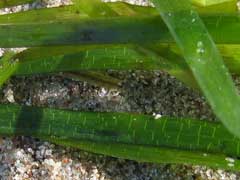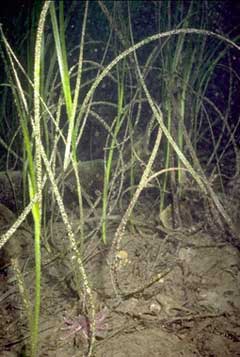 |
|
commons.wikimedia.org/wiki/User:Fabelfroh |
 |
|
Translate this page:
Summary
Physical Characteristics

 Zostera marina is a PERENNIAL growing to 1 m (3ft 3in). It is in flower from June to September, and the seeds ripen from August to October. The species is monoecious (individual flowers are either male or female, but both sexes can be found on the same plant) and is pollinated by Water.
Zostera marina is a PERENNIAL growing to 1 m (3ft 3in). It is in flower from June to September, and the seeds ripen from August to October. The species is monoecious (individual flowers are either male or female, but both sexes can be found on the same plant) and is pollinated by Water.
Suitable for: light (sandy) and medium (loamy) soils. Suitable pH: mildly acid, neutral and basic (mildly alkaline) soils and can grow in saline soils.
It cannot grow in the shade. It can grow in water.
UK Hardiness Map
US Hardiness Map
Synonyms
Plant Habitats
Pond;
Edible Uses
Edible Parts: Leaves Root Seed
Edible Uses:
Leaves - raw or cooked[177, 256]. The leaf bases are crisp and sweet, they were often used as a feast food by the native North American Indians[256]. Seed[177]. No more details are given. The root of the plant is chewed for its saccharine juice[2, 105]. The root is crisp and sweet, it was used as a flavouring by the native North American Indians and was also dried for winter food[256]. The raw rhizomes were often used as a feast food[256].
References More on Edible Uses
Medicinal Uses
Plants For A Future can not take any responsibility for any adverse effects from the use of plants. Always seek advice from a professional before using a plant medicinally.
Women's complaints
The leaves are used in the treatment of dropsy, goitre and women's illnesses[218].
References More on Medicinal Uses
The Bookshop: Edible Plant Books
Our Latest books on Perennial Plants For Food Forests and Permaculture Gardens in paperback or digital formats.

Edible Tropical Plants
Food Forest Plants for Hotter Conditions: 250+ Plants For Tropical Food Forests & Permaculture Gardens.
More

Edible Temperate Plants
Plants for Your Food Forest: 500 Plants for Temperate Food Forests & Permaculture Gardens.
More

More Books
PFAF have eight books available in paperback and digital formats. Browse the shop for more information.
Shop Now
Other Uses
Compost Packing
The dried leaves and stems are used as a packing material[46, 61, 66, 100]. The plant is frequently used as a manure[2].
Special Uses
References More on Other Uses
Cultivation details
A plant of shallow sea water, it is not really suitable for normal cultivation.
References Carbon Farming Information and Carbon Sequestration Information
Temperature Converter
Type a value in the Celsius field to convert the value to Fahrenheit:
Fahrenheit:
The PFAF Bookshop
Plants For A Future have a number of books available in paperback and digital form. Book titles include Edible Plants, Edible Perennials, Edible Trees,Edible Shrubs, Woodland Gardening, and Temperate Food Forest Plants. Our new book is Food Forest Plants For Hotter Conditions (Tropical and Sub-Tropical).
Shop Now
Plant Propagation
Seed - best sown as soon as it is ripe. Division.
Other Names
If available other names are mentioned here
Native Range
TEMPERATE ASIA: Egypt (Sinai), Israel, Jordan, Lebanon, Syria, Turkey, Russian Federation-Ciscaucasia (Ciscaucasia), Georgia, Russian Federation (Habarovskij kraj, Primorye, Kamcatskij kraj, Magadanskaja oblast, Sakhalin) NORTHERN AMERICA: Canada (Yukon (southwest), Québec, Nova Scotia, Ontario (northeast), Prince Edward Island, New Brunswick, Newfoundland and Labrador, British Columbia (west)), United States (Alaska, Maine, Massachusetts, New Hampshire, New York, Rhode Island, Connecticut, Oregon (west), Washington (west), Delaware, Maryland, North Carolina, Virginia (east), California), Mexico (Baja California (Norte), Baja California Sur, Sinaloa, Sonora) EUROPE: Denmark, Finland, United Kingdom, Ireland, Iceland, Norway, Sweden, Belgium, Germany, Netherlands, Poland, Russian Federation (European part), Estonia, Lithuania, Latvia, Moldova, Ukraine (incl. Krym), Albania, Bulgaria, Bosnia and Herzegovina, Greece (incl. Crete), Croatia, Italy (incl. Sardinia, Sicily), Montenegro, Romania, Slovenia, Spain (incl. Baleares), France (incl. Corsica), Portugal AFRICA: Algeria (north), Morocco
Weed Potential
Right plant wrong place. We are currently updating this section.
Please note that a plant may be invasive in one area but may not in your area so it's worth checking.
Conservation Status
IUCN Red List of Threatened Plants Status :

Growth: S = slow M = medium F = fast. Soil: L = light (sandy) M = medium H = heavy (clay). pH: A = acid N = neutral B = basic (alkaline). Shade: F = full shade S = semi-shade N = no shade. Moisture: D = dry M = Moist We = wet Wa = water.
Now available:
Food Forest Plants for Mediterranean Conditions
350+ Perennial Plants For Mediterranean and Drier Food Forests and Permaculture Gardens.
[Paperback and eBook]
This is the third in Plants For A Future's series of plant guides for food forests tailored to
specific climate zones. Following volumes on temperate and tropical ecosystems, this book focuses
on species suited to Mediterranean conditions—regions with hot, dry summers and cool, wet winters,
often facing the added challenge of climate change.
Read More
Expert comment
Author
L.
Botanical References
17
Links / References
For a list of references used on this page please go here
Readers comment
© 2010, Plants For A Future. Plants For A Future is a charitable company limited by guarantee, registered in England and Wales. Charity No. 1057719, Company No. 3204567.